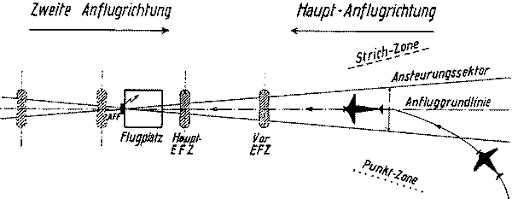Portrait of an Electron Tube
NF2 by Telefunken
JACMUSIC. Since 1993. All rights reserved. Copyright note
History
I first read about NF2, in a book about WW2 electronics and technology. Called "The Secret War" by Brian Johnson. I read it several times.
Imagine the days before electronic navigation of airplanes. There is navigation on sight, and navigation without sight. Without sight, to know what direction to fly, the pilot must first know exactkly where he is at that moment. That is done, by knowing the starting point, the flying direction, flying speed and flight time. Pencil this on the map, correct for side wind speed, and you know your position. This can be done blind by a good navigator, but the longer any landmarks can not be identified, the more difficult is gets. A problem is also finding the airport in total darkness or in a snowstorm. This was the situation in the years before WW2. There were only primitive methods for ground control to spot airplanes, and these worked not with high resolution, and range was very small.There was no way to guide a lost pilot back home.
The Germans were the first to develop a guide beam method, called "Knickebein": It consisted of two radio transmitters, in the 33Mhz band, each with an FM modulated signal with 180 degrees phase shift. Each producing a beam, which were radiated with a very narrow angle in between. These signals were each producing an audible tone, which tones were added together. When the tones are equally strong, the result is exactly zero. When one tone is louder, something will remain. So when the pilot was flying exactly in the middle of the two beams, there was no tone. When he drifts off, a tone appears.
This was on the edge of technology. On the one hand, you need to use a high frequency, because low frequency will not be able to focus well, or give good resolution. But high frequency does not have a very wide range, though it reached from the French coast to London, which was enough.

The British could receive those tones, but since they were beam focussed, they had to be on the beam axis. The Germans would also change the direction of the beams to fool the British. So this not understood for a long time what that tone was for.
Later, instead of a head phone, they used a panel meter with two needles, crossing each other, directly indicating what direction correction is needed. The next development was electronically coupled to the steering, and it was the first guided system. For absolute position, the Germans would use two such systems, in possible far distance from each other. Where those beams crossed, was the target. Afterwards, the same beam was used to fly back home. The closer you get to the source, the narrower the beam becomes, in, and it was possible to land the airplane exactly on runway without any visual contact at all.

The tubes
This required extremely stabile electronics and not just any tube. There was the CF7 tube, which is similar, but CF is for series connection and has 0.2Ampere heater, with 13V voltage drop. However CF has tolerance of the voltage drop, and the 0.2A must be precise. So you can not heat CF7 with 13V and not look at the current. Whereas NF2 is a 12.6Volt version, to be voltage driven, and you don't need to look at the current. Moreover NF2 is a military tube. I do not know at what data it is better than CF7, but given the application, it sure is a lot better.
Top Cap tubes
NF2 is has top cap grid. This gives low grid capacitance. Today, any top cap tubes are still unpopular. Also, side contact tubes are unpopular, and metallic painted tubes also nobody wants. And yes, NF2 has all of that, so luckily there is small interest from the Ebay crowd. It is amazing, but you can still buy NF2 as NOS tubes, from before WW2, and prices are fair. There are really not many tubes any more, of which we can say so.
Use for audio
Pentodes are nice when you want to drive a 300B with just one tube. They have enough gain, and noise of one pentode in a 50x gain stage is not higher than two triodes in series, having to do this. There is a classic schematic used by Jean Hiraga, using NF2 together with AD1. Something similar was later adopted by Yamamoto soundcraft, using C3m together with AD1. On my advice, Mr. Yamamoto used the AZ4 rectifier, to work with all European tubes. It might have been possible to build this AD1 amplifier with CF7 or NF2 as well, but I could buy 1000's of C3m tubes for him at the time, so he went for C3m.